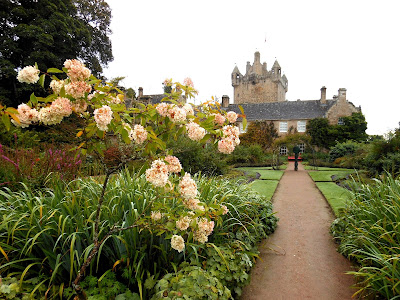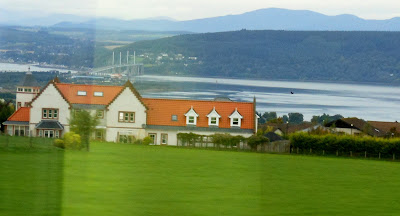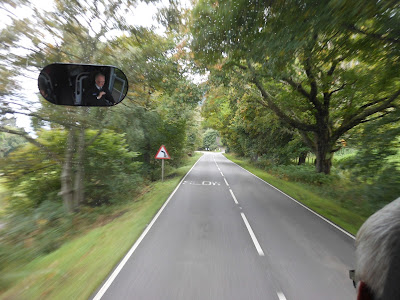Day 12 Inverness and Loch Ness Friday, Sept 22, 2017
This is a tiny part of the beautiful Cawdor Castle garden, our first stop on an all-day tour that also included Loch Ness and seeing parts of Inverness in the Highlands of Scotland. We also passed by Culloden Moor, where Bonnie Prince Charlie, in 1746, finally lost to the British in his attempt to put the Stuarts back on the English throne.
We hopped on our bus right after breakfast, which we had to grab as fast as we could in the buffet. The hardest part was finding a place to sit down to eat the food on our plates. Janet finally decided to sit at the empty handicap table. It worked. Besides, her ankle might start hurting.
Also, a funny side story: Because this would be an all-day scenic tour, we thought it would be nice to sit in the front seats, to get the best views. Thus, we did everything we could to be at the front of the lines for getting on the bus. Once we departed the ship near the front of the group, it was still a long walk across the pier to the buses. We noticed others rushing ahead for likely the same reason we were rushing, so I actually took off in all my track glory, and ran pretty fast for an old 66-yr-old, and scored the front seats on the bus!We ended up being glad we had these prime spots.
The photo above I snapped as the bus drove through the town of Alness (you can see the photo advantages of sitting in the front seats!). Our tour guide, who was a retired elementary school teacher and who told many interesting stories during the day and made us laugh a lot, explained how Alness was famous for winning numerous national floral competitions. Sure enough, the main street was loaded with flowers and I tried to capture these in my photo.
The tour guide explained the background of Alness winning all those floral awards: They built a huge aluminum factory in 1970, which employed about 1000 locals. With no forewarning, it abruptly went out of business in 1981 (due to EU competition) and overnight, 900 people were jobless. The town proactively wanted to "re-invent" itself, and decided to try to become famous using a "beautiful city" approach. It succeeded.
The map below shows where our shipped docked, in Invergordon, and where our tour visited during the day.
Invergordon is on the north side of a sheltered bay called the Cromarty Firth. The bus had to circle around the firth, going through Alness, and across a bridge into Inverness. We headed east along the bay to Cawdor Castle just below Nairn on the map. We then went back through the heart of Inverness (no stops) on our way to Loch Ness, which is the body of water on the map between Inverness and Fort Augustus. We ventured only about halfway down the loch, and returned to the ship going north through Beauly, Muir of Gold, and Dingwall.
Our first stop was Cawdor Castle, home of the "Thanes of Cawdor" since 1370 (a thane was a Scottish aristocratic royal land owner). It has remained in the same family over its entire 647 years, and the current Dowager Countess of Cawdor still lives in the castle during the tourist off-season. Thus, it was an interesting mix of old and modern.
You can see there is still a drawbridge to enter the castle.
Here's the drawbridge as we were about to cross it. There's now a tourist fence on either side, but the chains and wooden windlasses are still there and presumably operational.
The family coat of arms on the exterior wall, dated 1672, was in fine condition!
The above three photos are examples of what the interior looked like. Obviously, it's not furnished like 1370, but reflected that it's a residence as it has been for centuries. The rooms had artifacts, tapestries, treasures, and family heirlooms scattered about.
We thought their rifle display was interesting, as well as the chair and the flag on the pole that rests in the corner.
The old kitchen, on the other hand, was a museum of their old cookware and other items used in past decades and centuries.
As we exited the residence, they had some additional areas showing old collections besides the old kitchen. There were wagons, carts, and these two bicycles; the high-wheel cycle above is called a Penny Farthing.
And what respectable castle would be caught without its own whisky cellar?
In the basement, we got to see the preserved remnant of the legendary story of why the original castle was built on this site in 1370. The Thane of Cawdor had a dream of God telling him to load a donkey with gold and let it roam freely. Wherever it lay down to rest is where he should build his new home. Well, it lay down under this very holly tree! The original fortress tower was built up around this tree, and it's still part of the castle as you can see in this picture I took from the outside:
The original round-tower remains are in the lower right of this picture, but it was expanded in later centuries, such as the date on the triangle above the window is dated 1702.
Our favorite part of visiting Cawdor Castle was exploring the grounds and gardens. This was a beautiful view from a bridge behind, which led to...
...a sequoia tree, and a carved bench behind. There were paths to walk behind the river in lush greenery, but we didn't have time to take them.
We loved the carved bench. Janet is petting the hedgehog and its baby. I'm next to owls and a peeking doggie; we couldn't pose sitting down due to the rain water in the seats.
The Flower Garden, dating from 1600, is probably the castle's most famous feature. (The opening photo in this day's entry shows Janet in one part of it.)
It was vast, and truly beautiful to stroll around.
Two other of the many photos we took while enjoying the garden.
There also was a holly maze nearby, but I didn't see anyone trying to navigate it. Janet actually walked around it looking for me after we got separated for a while, but I was exploring across the river shown in the previous photos.
On our way back to the bus, we saw the children's playhouse wagon. I ventured inside to see the elaborate decorations on the ceiling and walls, and toys and tables on display.
As our bus traveled back to a hotel near Inverness for lunch, we passed several interesting sites which we could photograph from our prime front seats. This is the Culloden Viaduct, a railroad bridge from 1898 crossing over the Nairn River. There are 29 spans, making it the largest such bridge in Scotland.
I have no photos of this (they all came out blurry), but we also passed the Culloden Moor, the battlefield from 1746 when Bonnie Prince Charlie and his Jacobites lost to the British army loyal to King George II. It was a bit of history that weighs heavily on the Scots due to the cruel treatment of the Scottish Highlanders following their defeat. Please bear with me as I relate the historical details we learned from our tour guide, which I found interesting.
Queen Anne was the last of the Stuart British monarchs, and died in 1714 with no living children. The succession rules (passed by Parliament only 13 yrs earlier) gave the throne to George I, of the German House of Hanover. His claim to the throne was that his grandmother was the sister of King James I (who also was James VI, from a Scottish royalty standpoint). "Bonnie" Prince Charles Stuart and his father, who was the younger brother of both Queen Mary II and Queen Anne, had always been seeking a way to restore the House of Stuart to the throne. It was motivated more by religion than anything else, because Charles and his father wanted Britain to return to the Catholicism of their dad/granddad (James II).
In 1745, Charles went to the Scottish Highlands and formed an army of volunteers willing to regain the British crown by force. They were called Jacobites because Jacobus is Latin for James, and it was the Catholic James II to whom they linked themselves in wishing to restore his line to the throne. Charles was supported both financially and with troops by the French, who of course always held grudges against England.
Charles had complete success during the initial eight months of the campaign, but at Culloden Moor, his army was completely wiped out - 2000 dead or wounded, compared to 300 for the loyalists led by the Duke of Cumberland. Our tour guide described the infamous Highland Charge, which sounded pretty much like the failed Pickett's Charge during the Battle of Gettysburg. As our bus passed the battlefield, she pointed out banners showing the location of both sides during the Highland Charge, which was the final and disastrous effort by Bonnie Prince Charley.
This event in history continues to elicit emotions from Scots because the Duke of Cumberland, whom the Scots call "Butcher Cumberland", was brutal with the Jacobites; also, the British government passed laws to remove authority from Scotland and their landowners.
More photos taken from the bus's front seat on our way to lunch. There's the bridge we had taken earlier in the day on our way into Inverness.
This is downtown Inverness, the capital of the Highlands.
Crossing the River Ness. The population is 47,000, and Inverness was recently voted The Happiest Place in Scotland.
Our bus made no stops as we drove through Inverness, but we did pass right by the Inverness Castle, dating from 1836.
We then headed southwest along the River Ness and the Caledonian Canal, which allows boats to travel across the entire country from the eastern sea all the way to the western ocean, connecting Loch Ness, Loch Oich, and Loch Lochy across the so-called Great Glen.
An advantage of sitting in the front seats allows you to see the driver's face in the mirror. Just kidding, but we did get a wonderful view forward during our drives through the countrysides.
And then we reached Loch Ness. That sign also mentions the Great Glen, the long valley stretching across the entire country.
Our stop was at ancient Urquhart Castle, dating from the 13th century, and now in ruins. It provided beautiful views of the loch, where we could also watch for any signs of Nessie raising her head. Loch Ness is Scotland's largest loch by volume, and contains double the water of all lakes in England and Wales combined. It is 23 miles long, and about 600 feet deep for most of its length, but as much as 825 feet deep in many spots.
The castle history was interesting mostly in how many times it changed hands by various warring clans. Thus, it was frequently partially destroyed and rebuilt over the centuries.
This is a photo of their display showing what the castle would have looked like in the 17th century.
The current ruins date from 1692, when it was finally destroyed for good to prevent its use by Jacobite forces, and it subsequently decayed. In the 20th century, it was placed in state care and opened to the public: it is now one of the most-visited castles in Scotland. This view is to the northeast.
I tried hard to spot a dark spot popping out from the lake surface, but could not convince Janet I actually saw Nessie. The Nessie legend dates from 565 when St. Columba supposedly saw it, but its current popularity dates from 1933. First, a local guy claimed to have seen it, and he was the first to call it a "monster". Then a few months later, most likely due to that initial published report, a Londoner claimed that while they were
driving around the loch, he and his wife saw "the nearest approach to a
dragon or pre-historic animal that I have ever seen in my life"
trundling across the road toward the loch with "an animal" in its mouth. Oh my, it was crossing the road!
Then, in December of the same year, we got the first photo of Nessie, which was published in the British Daily Express. A few months later, the world got to see the very famous photo, which we've all seen, which is known as "the surgeon's photo," which in the 90s was proven to be a hoax. Nevertheless, there have been umpteen "sightings", including reports dating back to the 6th century.
Ruins ruins ruins.
Nope, no Nessie looking to the southwest either. Just Janet down there, who made a good choice not to climb up the steep narrow circular staircase to the tower top. People were going both up and down at the same time, and I had to back up, or the other person would, to be able to negotiate traffic in both directions.
There's what remains of the drawbridge over the moat. In the background, they have a replica of the catapults used by enemy attackers to fling cannon balls.
There's the catapult. We watched a video of experts seeing if they could fling cannon balls to hit a target about 100 meters away. With each miss, they would make slight adjustments until they creamed the target.
In the castle museum, Janet and I enjoyed reviewing this poster of a castle hierarchy. It had some similarities to what we had learned watching Downton Abbey, but was far more elaborate.
This was my final photo as our bus traveled back to Invergordon. Our guide continued to tell story after story about various sites or Scottish life, so we were continuously entertained and educated. As we passed through Dingwall, she told how in 1963 the Beatles played a concert there, with only 19 in the audience! It was a few weeks before their first hit, Please Please Me was released, and those 19 people suddenly had valuable ticket stubs!
As we returned to our ship, there again was Scottish entertainment on the dock! 14 kids in full dress were playing bagpipes and drums, and it was very cool. I took two videos, but my still photos didn't come out clearly. The ship guys were shoving us to hurry past and get back on board so they could leave on time.
As the ship sailed out of Cromarty Firth, we passed six or seven oil-drilling platforms that are not only made in Invergordon, but are brought back for repair and maintenance.
A fabulous day in the Scottish Highlands, narrated by a woman proud to be from Glenmorangie, just 19 miles from Invergordon. She gave an endorsement of Glenmorangie Scotch, which turned out to be our favorite brand once we decided to try different scotches. They produce 9 million bottles per year! (One of the possible ship excursions was to tour this distillery.) Earlier in our trip, our guide told how a 40-yr-old bottle of Dalmore scotch, made in Alness, sold for 120,000 pounds sterling!















































No comments:
Post a Comment